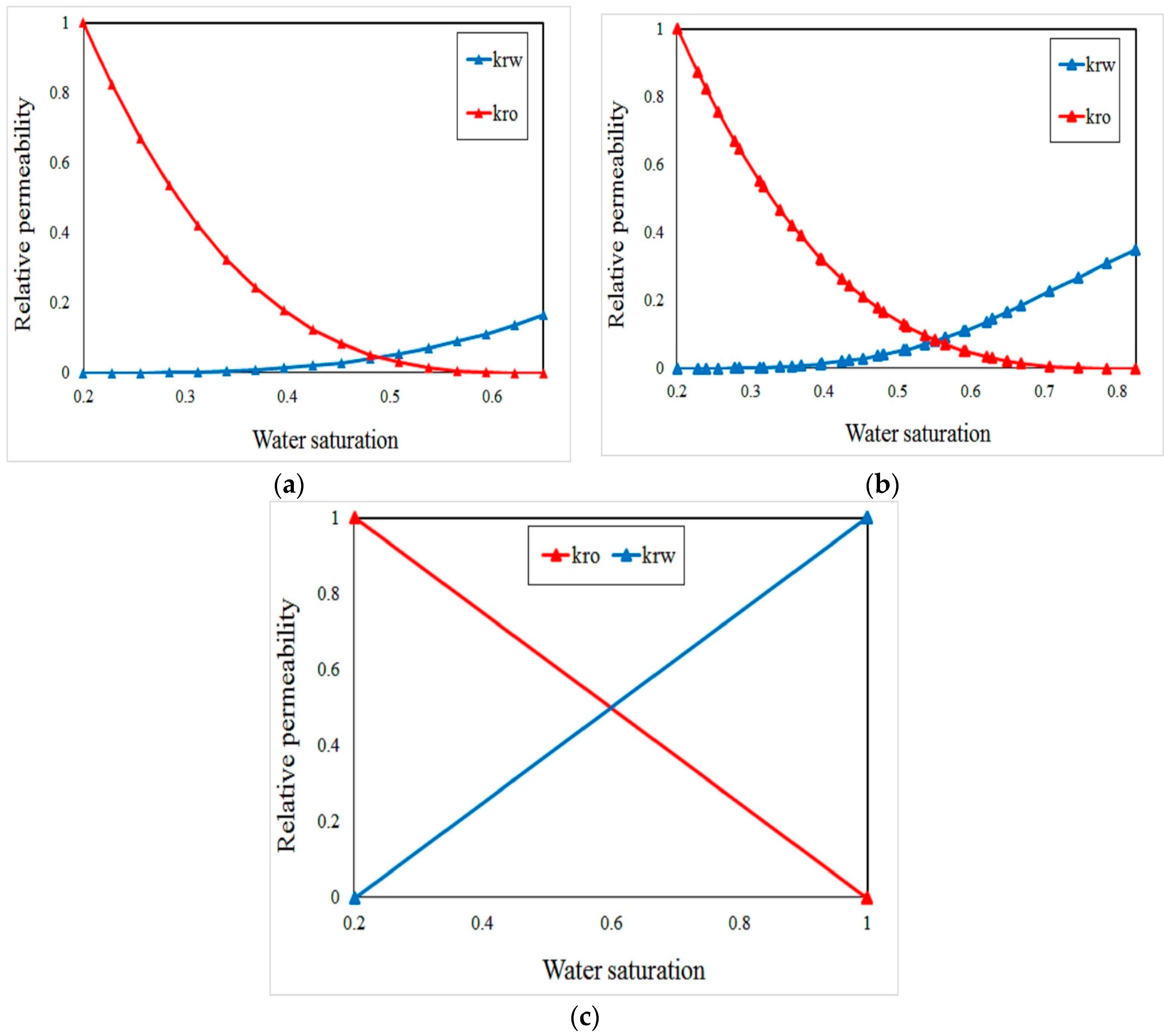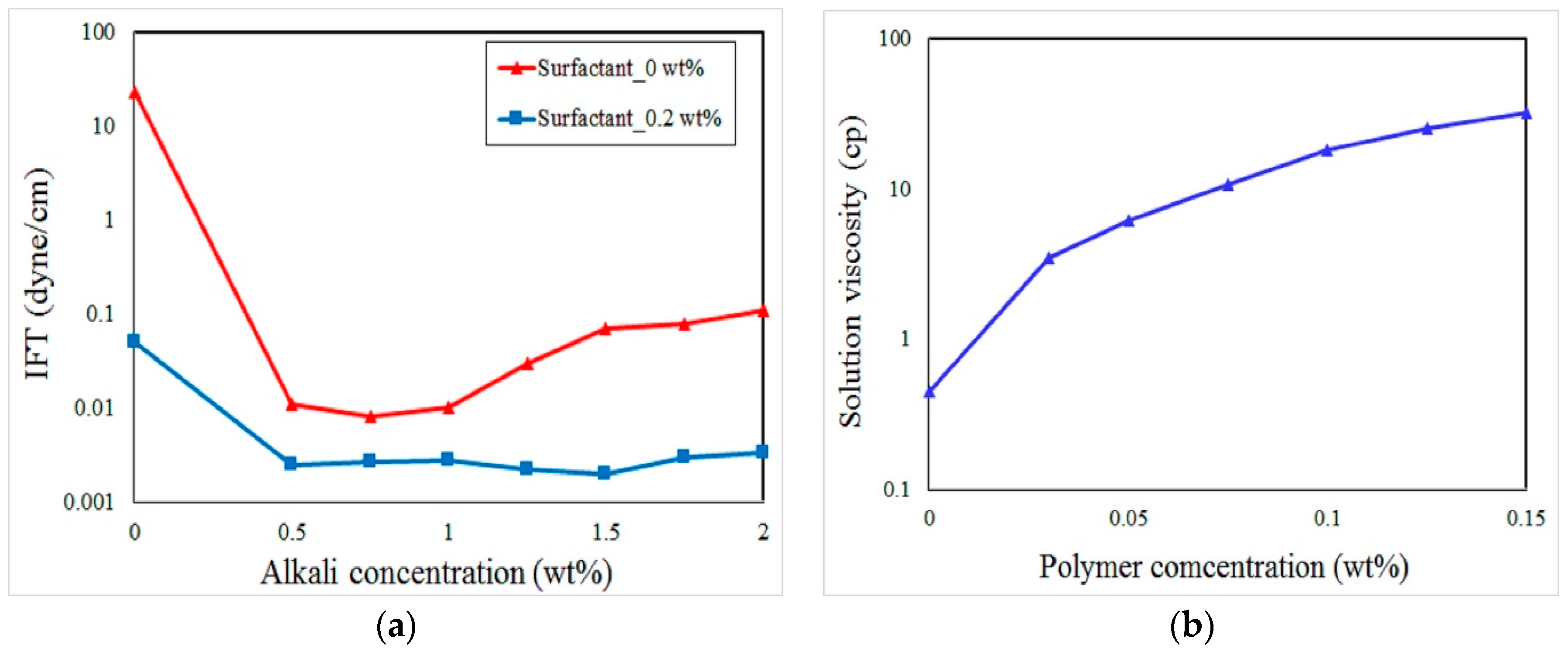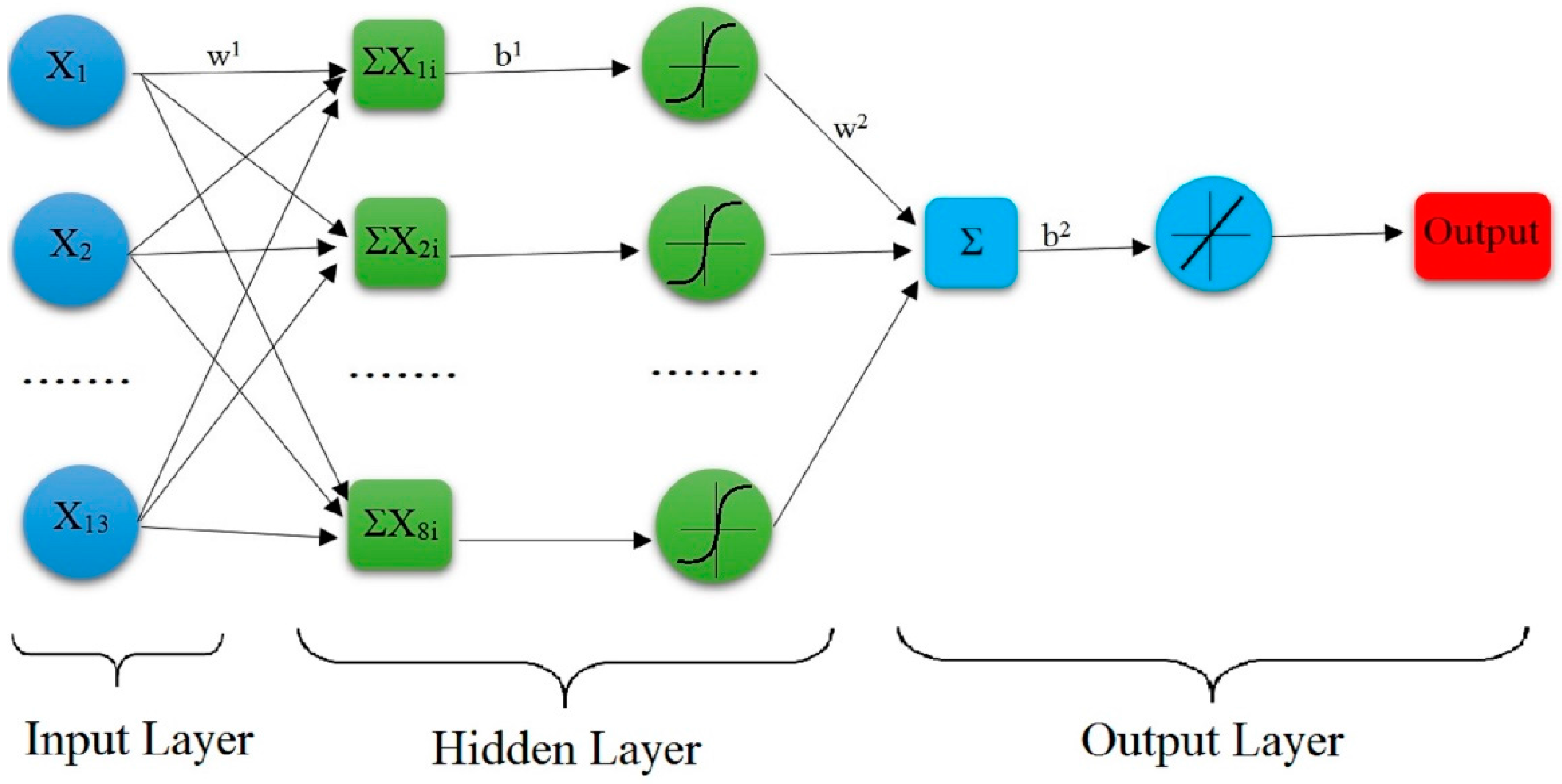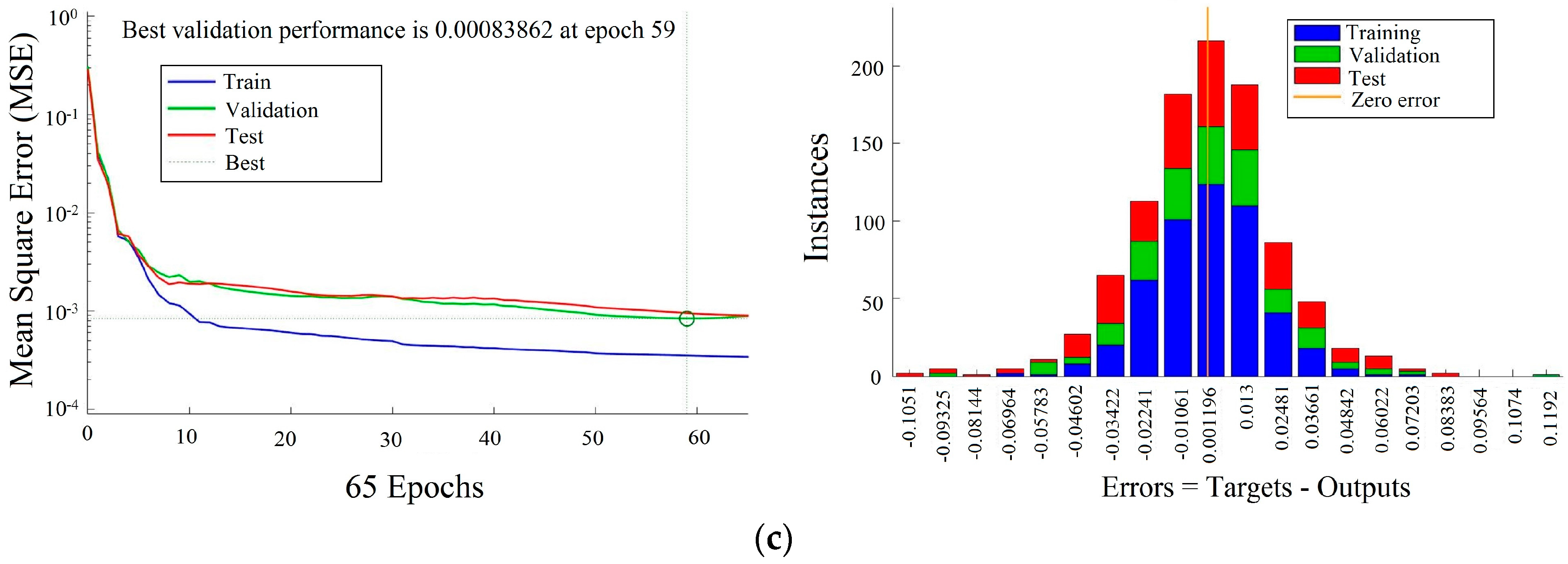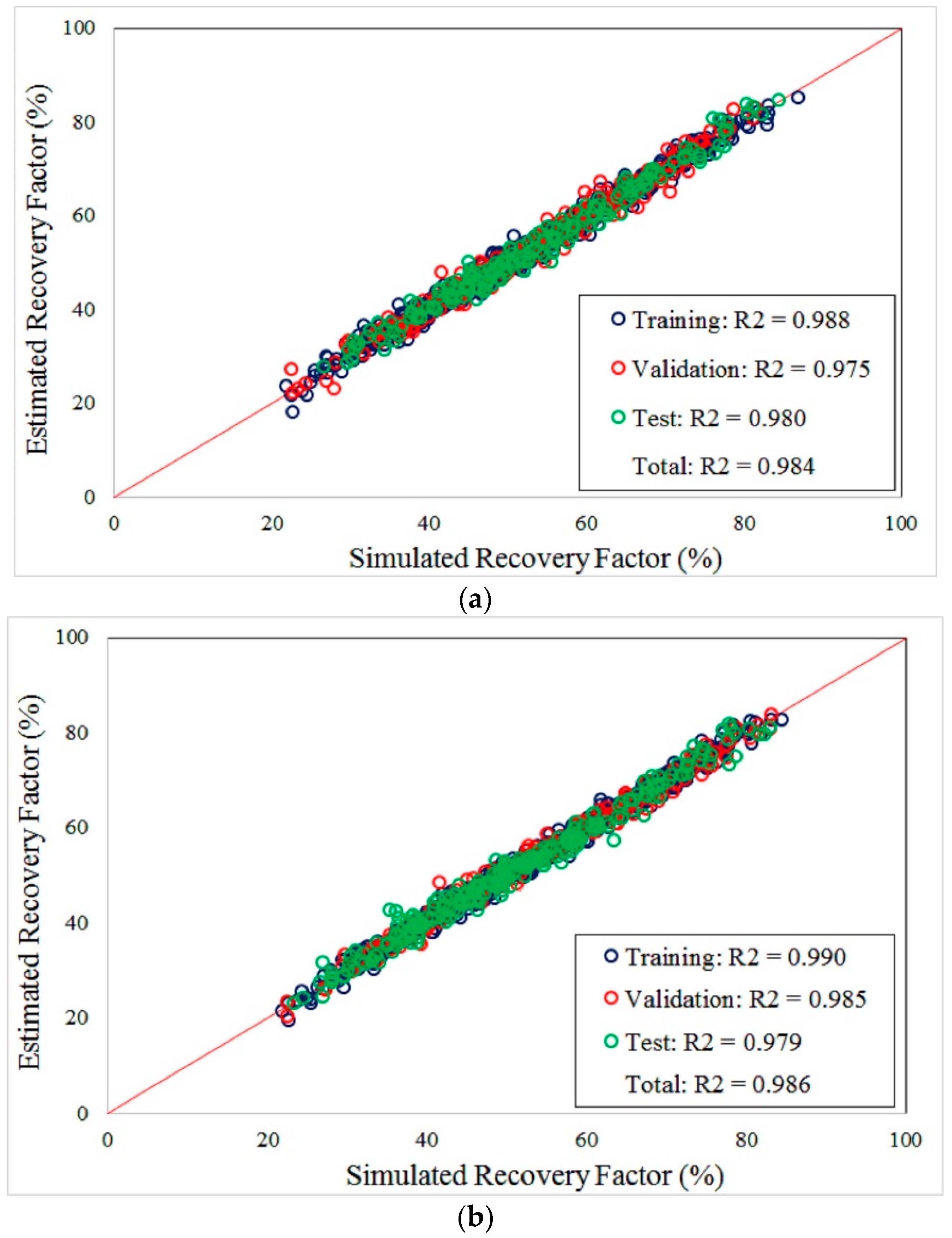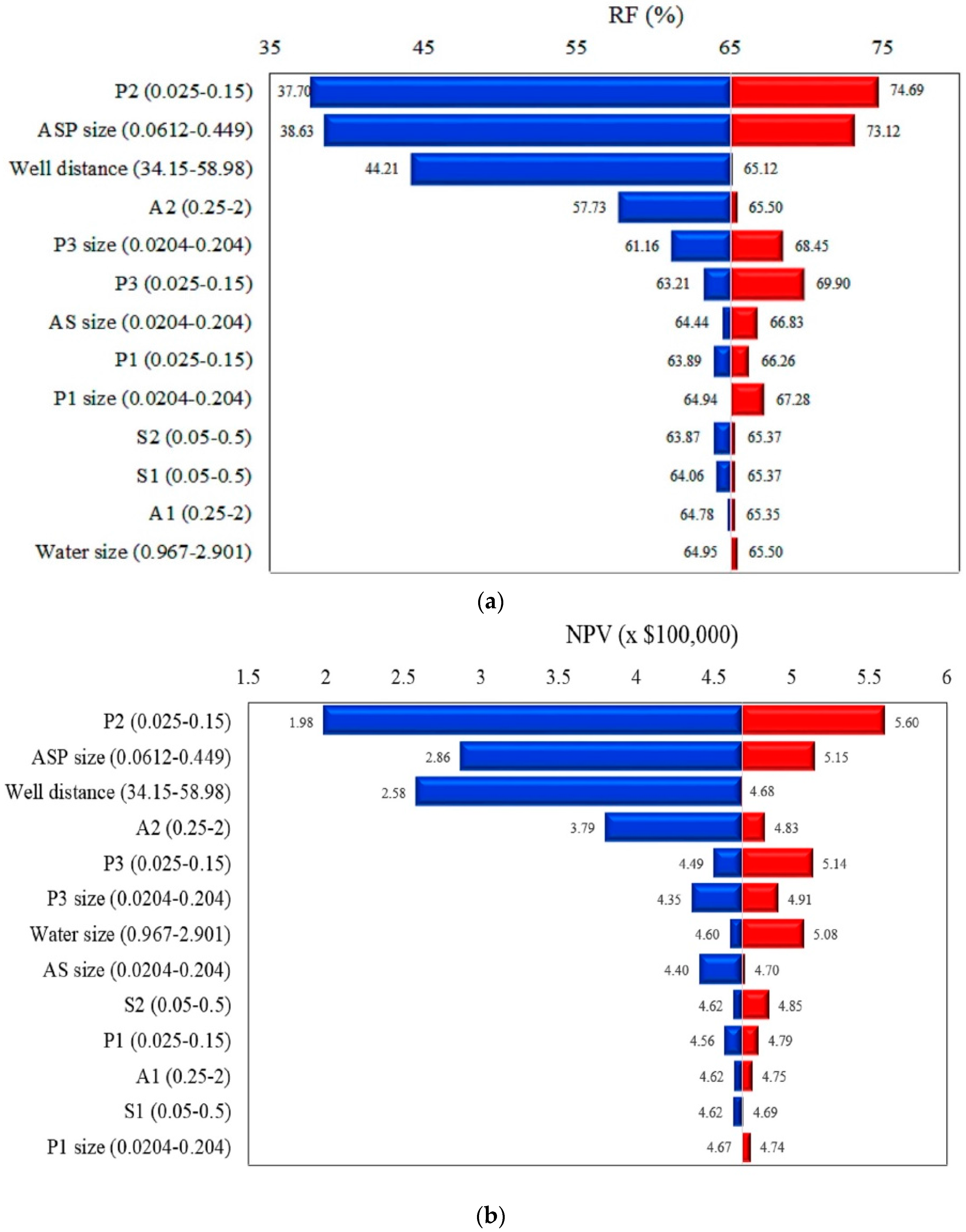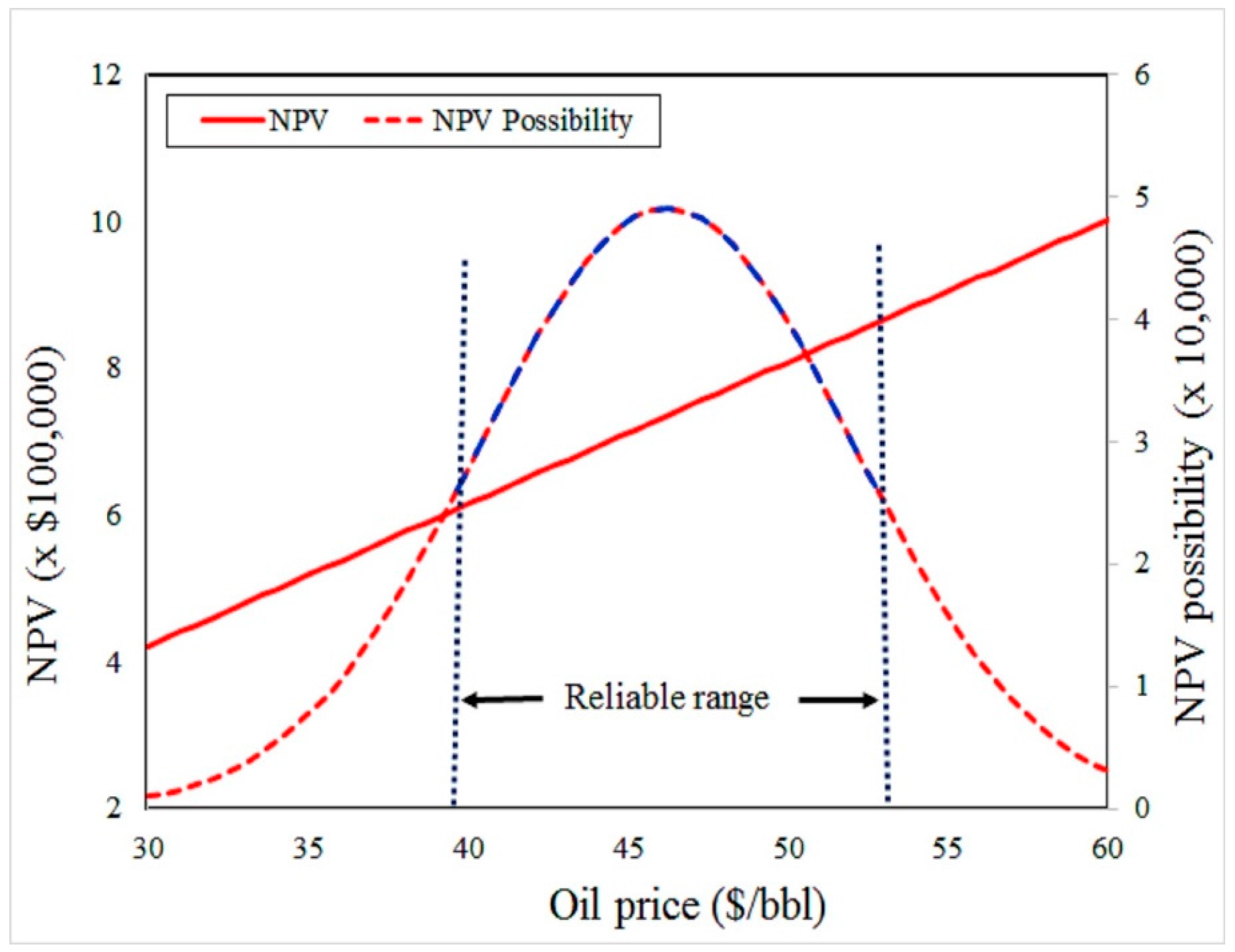1. Introduction
After a period of time of producing oil from natural energy reservoirs using primary and secondary extraction methods, enhanced oil recovery (EOR) methods are commonly considered to extract the large amounts of oil often remaining in reservoirs. The tertiary stage is basically categorized into three essential processes: thermal oil recovery, gas miscible/immiscible flooding, and chemical flooding [
1]. Thermal methods are suitable for heavy-oil or bitumen, while gas injection is widely used where sufficient gas supplies are available. Most importantly, oil recovery by carbon dioxide injection requires specific reservoir conditions to maintain the optimal sweep efficiency [
2], particularly the reservoir pressure must be continuously monitored to enhance the gas storage [
3]. The favorability of chemical flooding methods, which include alkaline (A)-surfactant (S)-polymer (P) flooding, is that these methods can be operated continuously in conjunction with water flooding without any addition complex integrated system [
4,
5]. The application of chemical agents for extracting crude oil has been commercially deployed, not only for conventional light oil, but also in some viscous oil fields over the world. Indeed, according to the reports of the journal
Oil &
Gas, the successful polymer flooding project in the Pelican Lake field in Canada could profitably produce more than 9540 m
3/day in 2014, whereas the pilot project in the Gudong field also recovered approximately 13.4% of the original oil in place (OOIP) in 1998 by ASP flooding [
6,
7,
8]. However, like other EOR methods, the successful application of chemical injections still depends on many factors including reservoir conditions, the type of crude oil or operating conditions, and most importantly the economic feasibility of the project.
Conventionally, core-flood tests and simulations are always considered to forecast the EOR performance of chemical flooding before deploying it in a real field. On the other hand, the large time consumed and high cost are always in concerns because injection jobs inevitably have high uncertainty. Further, an injection strategy is essential to achieve optimization of either the technical or economic aspects [
9]. With a low number of numerical simulations, the optimization methodology proposed by Zerpa et al. for a full field scale was used to investigate surrogate models for two ASP flooding scenarios and could be applied more generally to other ASP injection scenarios [
10]. Their later work demonstrated the use of response surface methodology (RSM) as an effective optimization tool for an ASP pilot project with the optimal polymer slug size 68.6% smaller than that suggested by laboratory design [
11]. In addition to chemical flooding, this mathematical tool has been also widely applied in other EOR processes for diverse professional analyses. Dai et al. conducted a response surface analysis for two objective functions using the results of 2000 Monte Carlo simulations for optimizing the CO
2-EOR process; they implied that understanding the uncertainty of the reservoir characterization would be critical in terms of economic decision and cost-effectiveness of the process [
12]. Their subsequent work proposed a response surface-based economic model to compute the profitability of CO
2-EOR for the Farnsworth Unit site taking into account the oil price; they stated the importance of oil price on the possibility of profit from 1000 realizations [
13]. Principally, a more proper prediction made by RSM, a larger number of designed samples is required, especially when a large number of variables is involved in the response function [
14].
The artificial neural network (ANN) has been applied widely in many aspects of the petroleum industry, but despite the diversity of its applications, there have been few studies of this method in chemical flooding. Using an ANN, Jawad and Jreou determined the horizontal well location in the AB unit of South Rumaila oil field with reasonable accuracy; they also affirmed the value of this tool for cases with a large amount of historical data rather than adequate engineering data [
15]. Instead of analyzing and predicting the production data by decline curves, Elmabrouk et al. utilized network models to match the history production data and provide an estimation from those data sets of an oil field in the Sirte Basin in Libya with a mean absolute error of approximately 10% [
16]. Further, the accurate estimation for horizontal well production performance by ANN to calculate the pseudo skin factor by Ahmadi et al. opened a potential coupling of their suggested model with commercial software to improve the accuracy and decrease the simulation time [
17]. Regarding EOR processes, Alizadeh et al. pointed out the superior prediction of ANN on predicting the oil recovery factor in the immiscible water alternating gas process compared to a mathematic tool [
18]. Their later work also on three-phase fluids flow in heterogeneous porous media affirmed the applicability of the ANN model based on the Scaling Group for accurately estimating the oil recovery potential in any given reservoir. In particular, the method can be useful for detecting the key parameters in a large database for immiscible WAG flooding [
19]. Beside the network model, an optimization tool also needs to be integrated for fully evaluating the performance of the models and figuring out the most dominant screening values in achieving the target. Shafiei and Dusseault developed a new screening tool based on ANN integrated with a Particle Swarm Optimization (PSO) method to predict recovery factors and cumulative steam to oil ratios in steam flooding for viscous oil in naturally fractured carbonate reservoirs, potentially opening the possibility of merging PSO-ANN with viscous oil recovery modeling software [
20]. They demonstrated that PSO-ANN is superior to BP-ANN at forecasting in this type of oil field with the maximum error of less than 8%.
In terms of chemical flooding, Wang et al. constructed EOR and IPR models for polymer flooding in reservoir blocks of the Shengli oil field by orthogonal design and a BP neural network with three oil prices; the model could potentially supply technical guidance for polymer injection implementation [
21]. Moreover, the ANN model for surfactant-polymer flooding has been built successfully with approximately 3% average absolute error from a set of 499 simulation data with 18 dimensionless groups involved in the input layer by Al-Dousari and Garrouch; they clearly stated that the model can save significant time in performance prediction compared to the simulation on SP flooding with reliable accuracy [
22].
Obviously, while the applications of a neural network are diverse and highly applicable, as presented in the literature there is still no representative model for estimation of the viscous oil reservoir situation as the use of chemical flooding in this type of oilfield has not been widely considered. Based on the abovementioned idea, this work aimed to generate an applicable network model to predict the ultimate oil recovery of chemical flooding process in a quarter five-spot pattern for a viscous oil reservoir. The numerical case study is referenced from a typical ASP flooding project in China, a validation for simulation in terms of chemical designs will be also presented in order to assure the reliability of the work. A huge number of samples collected from simulation results will be used to train the neural network, a best scheme of training will be also determined to achieve the most reliable model. Sensitivity and feasibility studies in terms of economic evaluation are proposed as the applications of the generated network model in which the oil prices are notably considered that represents the risk of economic condition.
The generated ANN model in this work can absolutely be reused in similar projects that basically have similar reservoir characteristics where there is a need to quickly predict the possible recovery factor for ASP flooding, particularly for further feasibility analysis that can also be flexibly carried out for different economic conditions.
3. Chemical Injection Design
Basically, the use of alkali aims to generate a surfactant in-situ in the reservoir by reacting with the acid components of crude oil, thereby reducing the interfacial tension between the oil and the aqueous phases and making the oil moveable [
26]. The addition of a synthetic surfactant to an alkali solution will increase the level of IFT reduction, but the combined alkali-surfactant injection can easily cause a severe viscous channeling phenomenon because oil will be easily bypassed by the displacing fluid, thereby leaving behind a large amount of oil. This problem can be tackled principally by using a polymer that makes the solution more viscous, thereby achieving the proper mobility control and significantly improving the sweep efficiency [
27,
28]. On the other hand, a high viscosity solution has decreased injectivity and consequently this results in a slower response at the producing well compared to the case where non-viscous fluids are injected [
29].
Regarding the simulation for chemical flooding, interpolation is basically the main numerical scheme of STARS for processing the variations in rock wettability, which is represented by the residual oil saturation, corresponding to the surfactant concentrations. This relationship originated fundamentally from the dependence of the residual saturation on the capillary number following the direct formula proposed by Pope and Nelson [
30], as presented below:
where
a and
b are constants,
Sor is the residual oil saturation, and
Nc is the capillary number. Obviously, since b is negative, the increase in capillary number primarily decreases
Sor, which finally straightens the relative permeability curves. Quy and Labrid developed the mechanism of oil displacement according to the range of capillary numbers in surfactant flooding, as oil can be displaced totally if ln(
Nc) > −6.725 and displaced partially if −8.255 < ln(
Nc) < −6.725 [
31]. The capillary number can be calculated as [
32]:
where
µ is the viscosity of the injected fluid, u is the Darcy velocity and
σ is the interfacial tension between oil and water. As the IFT relationship is established initially for alkali and surfactant concentrations, it will be interpolated adaptably during the simulation processes. The interpolation of rock wettability in this work is represented by the changes in the relative permeability curves, as shown in
Figure 1.
In terms of viscosity, the predefined viscosity table for an aqueous phase when adding a polymer will automatically generate a nonlinear mixing function,
fN, which limits the polymer concentration during the simulation. The function is formulated as [
32]:
where
µw is the water viscosity,
µp is the viscosity of polymer solution, and
pmax is the maximum viscosity of the injected solution.
Effects of salinity on viscosity inevitably occur as this composition helps decide the quality of the microemulsion when the polymer and surfactant are mixed contemporarily in an artificial brine. In addition, because the reservoir water always has a certain level of salinity, the initial expected viscosity of the displacing fluid might not be reached as a consequence. The consideration of salinity in STARS is expressed basically as [
32]:
where
µp is the solution viscosity with salinity,
is the defined viscosity of the polymer solution without salinity;
xsalt and
xmin are the salinity and effective threshold salinity of the solution, respectively;
sp is the slope of the log-log plot of the polymer viscosity versus ratio of current salinity over
xmin. The viscosity of polymer solution can be estimated more accurately before and during the simulation process because a specific salinity has been determined for artificial brine.
Based on the chemical properties, including IFT relationship, solution viscosity, and adsorption characteristics of the Gudong field project, this work applies these properties relatively completely for the simulation, as presented in
Figure 2. Practically, a combined alkali-surfactant-polymer (ASP) is often considered instead of a single agent following a relevantly designed injection sequence to extract oil most thoroughly in terms of the technical or economic point of views [
33]. As the flooding sequence of ASP injection in Gudong field has already been proven to be a typically effective sequence, this study also used the same injection strategy for the simulation.
Table 2 provides details of the chemical injection schemes. Owing to the different scale between the real project and this work, the precise injection rate was redesigned based on the referenced rate by dividing the practical rate by 16. A preflushing water slug is also proposed before injecting the chemical slugs simultaneously.
